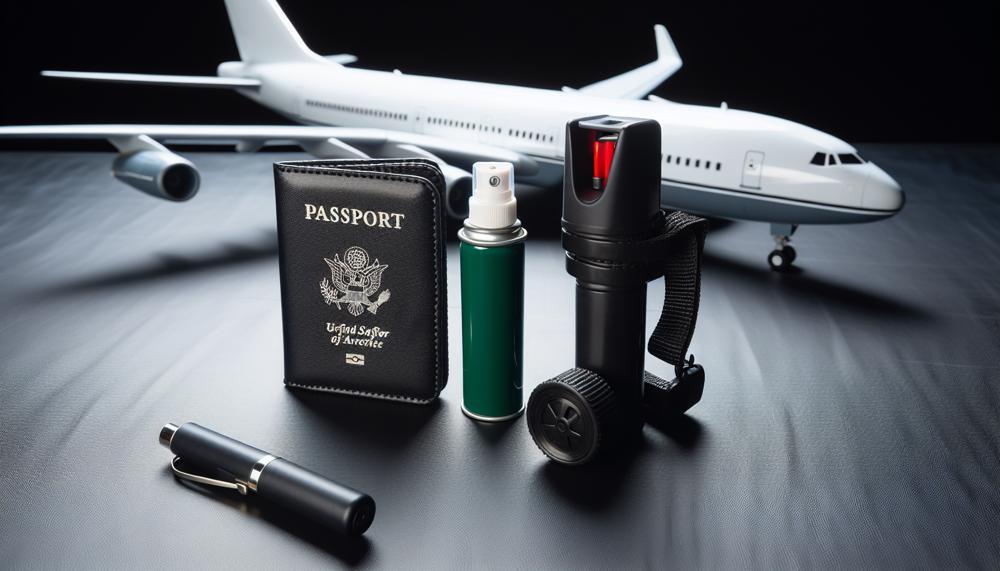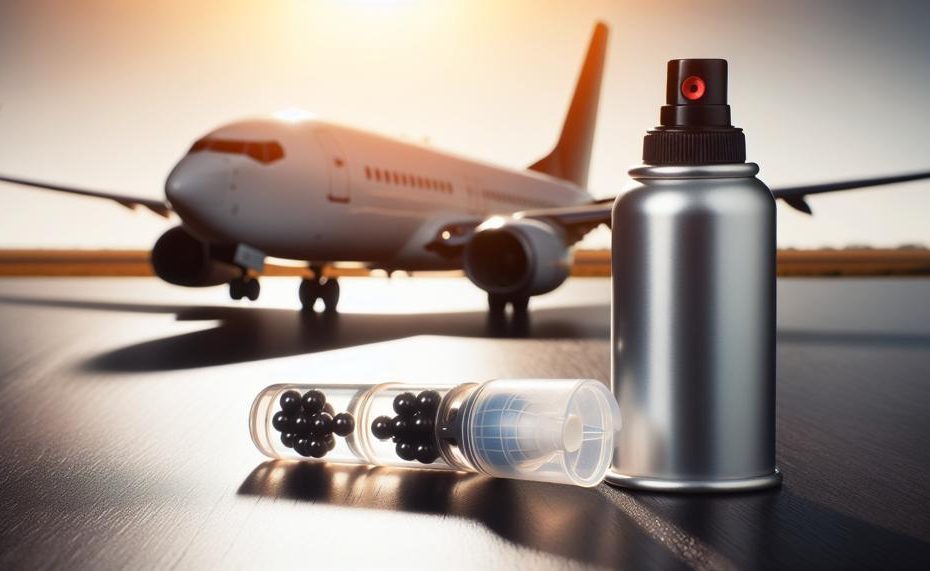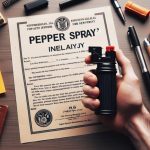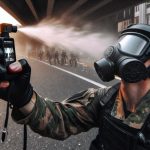As you prepare for your next flight, have you found yourself asking the burning question: will pepper spray explode on an airplane? This controversial topic has sparked a lot of discussion and concern among passengers. But fear not, we’re here to provide you with all the necessary information. So buckle up and get ready for a thorough exploration of this hot topic.
First things first, let’s break down what pepper spray actually is. It’s a popular self-defense tool that contains capsaicin, a fiery compound found in chili peppers. While it may be effective in warding off potential attackers, its potential to cause explosions on airplanes has raised some eyebrows.
Reports say that changes in air pressure and temperature can cause pepper spray canisters to explode mid-flight. This has caused the Federal Aviation Administration (FAA) to implement strict regulations on carrying pepper spray on flights. Additionally, many airlines have their own policies in place regarding the transport of this item.
But don’t worry, there are still ways to safely travel with pepper spray. It’s important to educate yourself on the rules and regulations before bringing it on board. And as always, safety should be your top priority.
Now that you’re well-informed about the controversy surrounding pepper spray on airplanes, let’s delve deeper into how it can potentially impact your air travel experience. So sit back, relax, and enjoy the ride as we uncover all there is to know about this fiery topic.
Contents
- 1 Can you fly with pepper spray in your carry-on?
- 2 Pepper Spray Travel Size
- 3 Can you take pepper spray abroad?
- 4 Is it illegal to carry pepper spray?
- 5 What self-defense weapons can you bring on a plane?
- 6 Can you bring pepper spray on a plane?
- 7 Does mace explode on a plane?
- 8 How to Travel with Pepper Spray
- 9 Best Pepper Sprays for Self Defense
- 10 Pepper Spray Regulations and Laws for Each State
- 11 Conclusion
Can you fly with pepper spray in your carry-on?
Unfortunately, no. According to TSA regulations, pepper spray is classified as a weapon and is strictly prohibited from being brought onto airplanes.
This rule applies to all types of pepper spray, including those labeled as self-defense sprays or personal protection sprays.
| Pepper Spray Type | Carry-On Baggage | Checked Baggage |
| Self-Defense Sprays | Nope, not allowed | Allowed with restrictions* |
| Personal Protection Sprays | Nope, not allowed | Allowed with restrictions* |
| Other self-defense sprays containing 2% tear gas or less | Nope, not allowed | Allowed with restrictions* |
| All other pepper spray types | Nope, not allowed | Nope, not allowed |
Restrictions for checked baggage include: the pepper spray must be packed in a container no larger than 4 ounces (118 mL), and the container must be leak-proof and placed in a clear, plastic, quart-sized bag.
Additionally, the container must have a safety mechanism to prevent accidental discharge.
Pepper Spray Travel Size
When considering bringing pepper spray on a flight, it is crucial to adhere to TSA regulations and your specific airline’s policies. To guarantee the safety of your pepper spray while traveling, follow these steps:
- Check the current TSA regulations: The Transportation Security Administration (TSA) has strict guidelines for what items are allowed in both carry-on and checked baggage. Pepper spray is prohibited in carry-on bags but may be permitted in checked baggage if it meets certain requirements. It is essential to review the updated regulations before packing your pepper spray.
- Confirm with your airline: While TSA regulations are consistent, each airline may have their own policies regarding pepper spray. Ensure you check with your specific airline before bringing pepper spray on a plane to avoid any complications at security.
- Adhere to TSA guidelines: If you plan on packing pepper spray in your checked baggage, it must be 4 ounces or less, have a safety lock to prevent spilling, and contain no more than 2% tear gas. Failure to comply with these guidelines may result in your pepper spray being confiscated at security.
- Pack it properly: When packing your pepper spray, ensure it is securely sealed in its container and placed in a clear plastic bag. This will make it easier for TSA agents to inspect during the security screening process.
- Keep it accessible: In case of an emergency, it is important to have your pepper spray within reach. While it may be tempting to pack it in your checked baggage, consider keeping it in your carry-on so you have quick access to it if needed.
| Pepper Spray Container Size | Safety Lock | Tear Gas Content |
| 4 ounces or less | Required | No more than 2% |
Furthermore, it is crucial to thoroughly research and follow TSA regulations and airline policies when traveling with pepper spray.
By adhering to these guidelines, you can ensure the safety of your pepper spray and avoid any potential issues at security.
Always prioritize safety and follow proper packing procedures to make your travel experience as hassle-free as possible.
Can you take pepper spray abroad?
When deciding to bring pepper spray on a plane, it’s crucial to understand the regulations for both domestic and international travel.
While it may be allowed in checked baggage for domestic trips, the rules become more stringent when traveling abroad.
International Travel Regulations
Traveling internationally requires thorough research and adherence to the regulations of the destination country. Some countries may prohibit the use or possession of pepper spray altogether, while others may have specific requirements or limitations.
For instance, certain countries may only allow a limited amount of pepper spray to be brought in or restrict its use for self-defense purposes only.
TSA Regulations
As per the Transportation Security Administration (TSA), carrying pepper spray as a carry-on item on any airline is strictly prohibited. This means that you cannot bring it in your carry-on bag, purse, or pocket when going through security checkpoints.
However, one 4 fl. oz. container of pepper spray is allowed in checked baggage as long as it has a safety mechanism and does not contain more than 2% tear gas.
Airline Policies
It’s essential to note that some airlines may have conflicting information or additional restrictions regarding pepper spray. To avoid any confusion or difficulties at the airport, it is advisable to have the TSA webpage on hand for reference.
Additionally, bear spray (used for protection against wild animals) is not permitted on planes at all, even in checked baggage.
Other Considerations
Apart from complying with TSA and airline regulations, there are a few other things to keep in mind when traveling with pepper spray:
- Keys with attached pepper spray are not allowed through security checkpoints.
- Pepper spray lighters (lighters with pepper spray attached) are prohibited as carry-on items.
- Pepper spray can expire after 2 to 5 years, so be sure to check the expiration date before traveling.
Is it illegal to carry pepper spray?
When it comes to traveling by plane, pepper spray and mace are allowed in checked baggage but not in carry-on bags.
This is due to safety concerns as they are classified as weapons and can pose a threat to other passengers in the confined space of an airplane cabin.
International Travel:
When traveling internationally, the rules for bringing pepper spray are stricter compared to domestic flights.
In general, most countries do not allow pepper spray or mace to be brought onto a plane, whether it is in checked baggage or carry-on bags.
Some countries may allow small amounts of pepper spray in checked baggage, but it’s important to research the specific country’s regulations before traveling.
Additionally, declaring the pepper spray at customs upon arrival is highly recommended to avoid any potential issues.
| Country | Pepper Spray Allowed? | Notes |
| United States | Yes | -Allowed in checked baggage -Not allowed in carry-on bags |
| Australia | No | -Not allowed in checked or carry-on bags -Considered a prohibited weapon |
| Canada | Yes | -Allowed in checked baggage -Not allowed in carry-on bags -Cannot exceed 2% concentration of oleoresin capsicum |
| United Kingdom | Yes | -Allowed in checked baggage -Not allowed in carry-on bags -Cannot exceed 4% concentration of oleoresin capsicum -Must be purchased from a licensed seller |
| Japan | No | -Not allowed in checked or carry-on bags -Considered a weapon |
While it may be tempting to bring pepper spray on a trip for self defense, it’s crucial to always double check with the airline and country regulations before packing it in your luggage.
What self-defense weapons can you bring on a plane?
The regulations and guidelines for bringing self-defense weapons on a plane can vary greatly, depending on the type of weapon, the airline, and the destination.
Generally, the Transportation Security Administration (TSA) prohibits firearms, knives, and other weapons from being carried on or checked in on flights. This is to ensure the safety of passengers and prevent any potential threats.
However, there are some exceptions for certain weapons with restrictions. For example, bulletproof vests can be brought in carry-on luggage but must be declared at security.
Additionally, tasers and self-defense keychains with sharp ends are considered prohibited weapons and cannot be brought on a plane.
Can you bring pepper spray on a plane?
Pepper spray, derived from a chili plant, is allowed on planes but only in checked bags. However, it is not permitted in carry-on luggage according to TSA regulations and most airlines.
Travelers must ensure that pepper spray in checked bags follows specific rules regarding size, type, and packaging. It is also important to check the laws of the destination country before bringing pepper spray.
Major airlines such as American Airlines, Delta, United, and Southwest all adhere to TSA regulations for pepper spray in checked bags. However, each airline may have its own set of guidelines and restrictions, so it is advisable to check with the airline prior to traveling.
Regulations for bringing pepper spray on a plane vary depending on the country and airline. As previously mentioned, the TSA allows pepper spray in checked bags if it follows certain rules.
These include:
- The pepper spray must not exceed 4 ounces in size
- The pepper spray must be intended solely for self-defense purposes
- The pepper spray must be securely packed in a container designed for it (such as a canister)
- The container must have a safety mechanism to prevent accidental discharge
- The container must be leak-proof and made of a sturdy material (e.g., metal or plastic)
- The container must be packed in a secure outer packaging (e.g., a box) to avoid accidental discharge during transport
It is important to note that these are general guidelines and may vary depending on the airline. Some airlines may have stricter rules, such as limiting the size of the pepper spray to 2 ounces instead of 4.
Travelers should adhere to TSA regulations and check with the airline. They should also research the laws and regulations of their destination country. This is important before bringing pepper spray.
Some countries have strict regulations or outright bans on carrying pepper spray. It is crucial to conduct research beforehand to avoid legal issues.
Does mace explode on a plane?
Traveling with mace or pepper spray on a plane requires prior planning and strict adherence to TSA regulations and airline policies.
While it is prohibited as a carry-on item, certain airlines may permit it in checked baggage with certain limitations in place.
However, it is crucial to consult with the specific airline beforehand and have all necessary documentation readily available.
Additionally, travelers should also verify the expiration date of their pepper spray, research state laws, and be aware of international travel restrictions.
| Airline | Carry-On Policy | Checked Baggage Policy |
|---|---|---|
| Delta Airlines | Not allowed | Allowed with restrictions (container must have safety mechanism, no larger than 4 fluid ounces, and contain no more than 2% tear gas) |
| United Airlines | Not allowed | Allowed with restrictions (same as Delta Airlines) |
| American Airlines | Not allowed | Allowed with restrictions (same as Delta Airlines) |
| Southwest Airlines | Not allowed | Allowed with restrictions (same as Delta Airlines) |
While major airlines have similar policies regarding pepper spray. It is important to note that some smaller airlines may have conflicting regulations.
Therefore, it is always advisable to verify with the specific airline before traveling.
The TSA also has strict guidelines on the type of pepper spray that is permitted on planes. For instance, the container must have a safety mechanism to prevent accidental discharge and the maximum allowed size is 4 fluid ounces.
Additionally, the pepper spray cannot contain more than 2% tear gas (CS or CN).
It is recommended to check the expiration date of your pepper spray before traveling, as expired containers will not be allowed on planes.
How to Travel with Pepper Spray
When taking a flight with pepper spray, it’s crucial to adhere to the guidelines set by the Transportation Security Administration (TSA) and your chosen airline to ensure a smooth and safe journey. Here are the key considerations to keep in mind:
- Consult your airline’s website: Before bringing pepper spray on board, be sure to check your airline’s website for their specific protocols and regulations. Some airlines may have their own policies regarding pepper spray in checked baggage.
- Pack it in your checked luggage: Pepper spray is strictly prohibited in carry-on bags or personal items. It can only be packed in your checked luggage.
- Follow TSA regulations: The pepper spray container must not exceed 4 ounces, have a safety lock to prevent leakage, and contain no more than 2% tear gas. Failure to adhere to these regulations may result in confiscation of the pepper spray by TSA.
- Other self-defense sprays may also be allowed: Along with pepper spray, other self-defense sprays such as mace or bear spray may also be permitted in checked baggage as long as they contain no more than 2% tear gas.
- Consider country laws: While pepper spray may be legal in certain countries, airlines may still have their own restrictions against it. In countries where it is illegal, it should not be brought on board at all.
- Pepper spray will not explode during the flight: Despite common belief, pepper spray will not explode on an airplane due to the low temperatures during flight. While it may become highly flammable when aerosolized, the risk of this happening on a plane is extremely low.
Best Pepper Sprays for Self Defense
The top picks for the best pepper sprays for self defense include the SABRE Advanced Pepper Spray Keychain. Also, the Wrist Saver Pepper Spray for Runners, and SABRE Advanced Compact Pepper Spray.
These options all feature a potent blend of ingredients and user-friendly designs. Additionally, the SABRE Advanced Pepper Spray Keychain with Case and POM White Pepper Spray Keychain Model are highly recommended. They are convenient and long-lasting.
When bringing pepper spray on an airplane, it’s crucial to comply with TSA and airline guidelines. This involves ensuring that the pepper spray is in its original packaging. The manufacturer’s label must be intact. Also, the container is no larger than 4 ounces.
It’s important to inform airline staff during check-in about the pepper spray so they can handle it properly during security screening.
Pepper Spray Regulations and Laws for Each State

Traveling with pepper spray requires knowledge of the specific laws and regulations for each state. While the TSA permits one 4 fl. oz. container of pepper spray in checked baggage, individual airlines may have their own restrictions. Additionally, different countries may have varying laws regarding possession and transport of pepper spray.
We have compiled a comprehensive list outlining the legal restrictions and regulations for carrying pepper spray on an airplane in each state. We will assist you in navigating these regulations.
| State | Legal Restrictions and Regulations | Notes |
| Alabama | The use of pepper spray for personal protection is legal in this state, as long as the container does not exceed 2.5 ounces. | – |
| Alaska | In this state, it is permissible to use pepper spray for personal protection, as long as it does not exceed 4 ounces. | – |
| Arizona | Pepper spray can be used for personal protection in this state, as long as it does not exceed 2.5 ounces. | – |
| Arkansas | The use of pepper spray for personal protection is allowed in this state. | – |
| California | Pepper spray can be used for personal protection in this state, as long as it does not exceed 2.5 ounces. | – |
| Colorado | In this state, pepper spray can be used for personal protection, as long as it does not exceed 0.5 ounces. | – |
| Connecticut | Pepper spray can be used for personal protection in this state, as long as it does not exceed 0.5 ounces. It must be purchased from a licensed firearms dealer or pharmacy, with a valid ID. | – |
| Delaware | In this state, pepper spray can be used for personal protection, as long as it does not exceed 1.5 ounces. | – |
| District of Columbia | Pepper spray can be used for personal protection in this state, as long as it does not exceed 2 ounces. | – |
| Florida | In this state, pepper spray can be used for personal protection, as long as it does not exceed 2 ounces. | – |
Conclusion
In summary, pepper spray is a common and effective self-defense option. Its presence on airplanes is strictly regulated due to the risk of explosions.
While it can be packed in checked baggage with limitations, it is prohibited in carry-on bags.
When traveling with pepper spray, it is essential to thoroughly research and follow TSA regulations and airline policies.
Safety should always be a top priority, so it’s important to comply with guidelines for a hassle-free flight experience.





